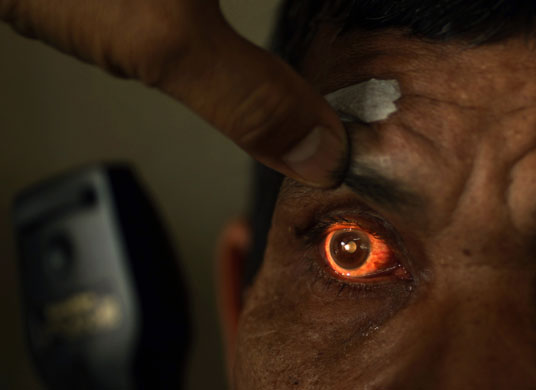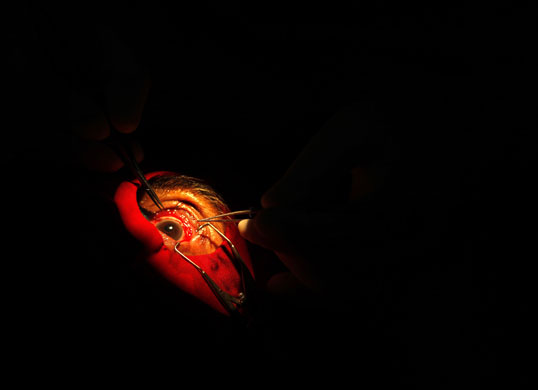The eye can see a great deal, but it rarely sees itself, and never directly. Perhaps that is one reason why photographs such as this one remain somewhat scandalous.

This close-up of an eye exam in Indonesia exposes the eye as an object of sight. We see a soft, wet organ, an aperature that ironically looks camera-like, and coloration that we know isn’t normal. The orange and red could be a sign of disease or only a diagnostic dye, but in any case the organ’s vulnerability is highlighted. The blunt thumb holding up the eyebrow is there to help, but it could just as easily blind the man, whose fragment of a face is tense with the strain of holding his eye unprotected before a bright light. His mute fear becomes even more animal-like when contrasted with the optical instrument in the left foreground. We are seeing an eye, but one that is trapped, first in disease and then in the clinical apparatus. His eye has been made an object of the clinical gaze, which comes from outside the frame.
This staging becomes even more intense in the next photograph.

Once again, we see an eye isolated as an object of clinical manipulation guided by an instrumental gaze signified by medical instruments. All the dramatic values have been enhanced: the eye is more fully decontextualized, with even the face now absent; the instruments now are inside the eye cavity during surgery; the light on the eye is harsher while the eye itself is immobilized (and sure to be harmed if it moves). This is a moment of extreme vulnerability, but if any emotion is to be supplied it has to happen without any cue from the patient, who in fact could be anaesthetised. The emotional vector, if any, will follow another feature common to both images: the presentation of this clinical intervention to a third viewpoint, that of the spectator.
Every photograph can be thought of as being reflexive, that is, as showing not only some part of the world but also the act of seeing. That seeing can be further refined as seeing photographically, and as seeing individually, or publicly, or in many other senses as well. The two images above operate somewhat like popular science writing: they put the viewer alongside a medical intervention as if you could be part of the scene on the basis of your interest rather than actual expertise. Thus, one watches as if an attending physician or as if in an operating theater, but actually from a third position of the public spectator who becomes aligned with the structure of expertise.
It probably is significant that both the expert and public viewers are not visible. The eye being seen is completely subordinated to being an object of sight rather than a perspective on those watching, and one should note that the embodied eye is poor in the first case and blacked out in the second. So, it might seem that these images are not reflexive: the clinical eye is the eye examined, not that of the examiner, and the public is not represented in any form but the photograph itself. But as I’ve tried to suggest, the images can reveal quite a bit about two intertwined ways of seeing.
Photographs by Beawiharta/Reuters,
The emotional reaction captured within the patients gaze is incredible, and I agree that his eye has been made an object of the clinical gaze. Gaze is a looking practice of an image and the viewer. The gaze also helps to establish relationships of power. In the first photo the patient is in control and represents it through his softer gaze off to the side as he is being examined. The second photo however shows the doctors in full power, because his gaze is much more intense and you can since his fear within his gaze. The second image creates a more powerful image than the first because of the patient’s intense gaze.
The dramatic values of the photos are also being enhanced through color with binary opposition. Binary opposition is identifying the opposite nature of an event and in these two photos it is represented through light and dark “red examining light and the dark background”. The red light highlights the eye in a way to make it the focal point of the photo. The color red also represents negativity when referring to the eye as diseased. The angle of the photo creates an environment where you feel face-to-face with the patient. It represents the perspective of the doctor, and places you within the examining room.
Though both photographs are visually appealing with striking colors and incredible detail, I believe their main difference lies in the ability of each photograph to produce an emotional response from the viewer.
The hesitation and fear of the patient can clearly be scene within the first photograph; this gives the photograph emotional content and clearly has the ability to invoke an emotion of sympathy from the viewer. It is the patient’s expression that brings emotional content to the photograph. When I looked at the first photo I immediately thought to my self as being in that situation and began to sympathize with the subject. This is because the photograph was framed in such a way that it not only showed the vulnerability of the patient put it also gave a sense of connection between the viewer and the situation. Almost every person has had an eye exam, and knows exactly the vulnerability that comes with being that exposed. This photograph combines the viewer’s personal knowledge of the situation with the emotional content provided by the subject in the photograph. The result is a particular emotional response from the viewer.
The second photograph, though more invasive and clearly more uncomfortable for the subject (that is if he is in fact awake.) lacks the ability of the first paragraph to create a strong emotional response from the viewer. When I looked at this photograph I was more interested from a scientific stand point as to why the eye was put in this particular situation, and what type of procedure was being performed on the eye? I believe this is because the way the picture is framed lacks the emotional. The viewer can not see the owner of the eye and thus can not reed his facial expression. The lack of an individual within the photo makes the eye to me en inanimate object. Also the darkness of the surrounding environment don’t allow the viewer to frame the eye within a situation. This lack of a person with emotions combined with a lack of background to frame the situation disconnects the viewer from the influence of emotional content. Instead the viewer can look at the photograph as pure informational content, without emotions only questions remain. The viewer begins to look for knowledge and answers to questions.